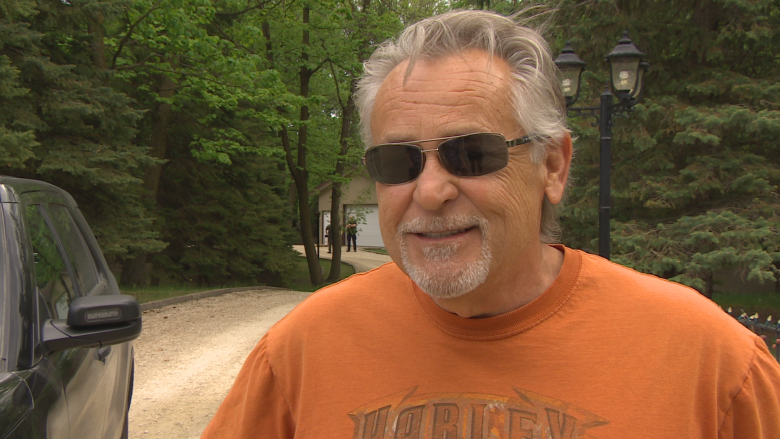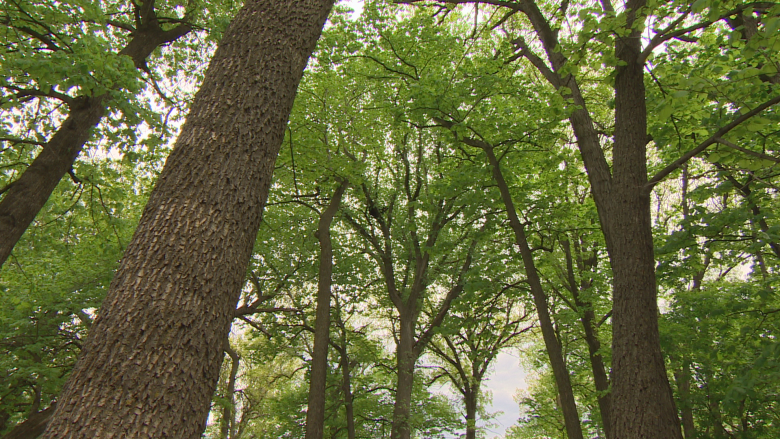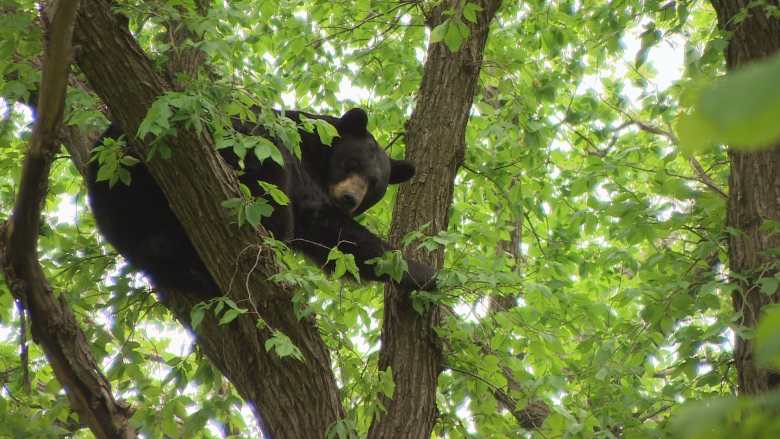'Bears live amongst us': Manitoba black bear gets comfy in backyard tree
Police and Manitoba conservation officers are playing the waiting game with a large black bear who climbed high up a tree in a residential area.
Michael Seaman, who lives just south of the Winnipeg perimeter, got a call from a neighbour Saturday morning who said the bear had settled down in a tree in the backyard of a home not far from Seaman's house.
Seaman went to check it out to see what all the fuss was about.
"[In] probably the biggest tree on the property, maybe even in the neighbourhood, is this humongous bear. It's about 300 pounds — I mean, I'm guessing at the weight, but it looks just huge," Seaman said.
"And it's way up the tree, probably about as high as you'd ever seen a bear in a tree."
It's hard to spot the bear in his lofty perch, but Seaman said he could hear him from the ground.
"You can see the broad outline of the bear. He's hidden in the leaves and the branches. But you can hear him chuff … I guess he wasn't happy at the crowd that was watching."
Seaman said a lot of wildlife passes through the neighbourhood, but in the 20 years he's lived there, the bear is the biggest guest he's seen.
'We live in their backyard'
Robert Belanger, a conservation officer with the province, said it's "not odd at all" for bears to make appearances within, or near, city limits.
"Bears live amongst us. They are around us all the time. We live in their backyard," he said.
"Everybody's always shocked to see a bear in the city of Winnipeg, when in actuality the bears are around the neighbourhood all the time. They're on the fringe. They follow the river, they follow creek beds. We just don't see them as often as we do foxes or coyotes, but certainly bears are around us."
But getting the large animals back to the wild isn't easy, he said. The usual plan is to tranquilize the bear while it's in a tree and then either lower it down on a rope or let it fall to the ground, depending on how high up it is.
In this case, the bear was so high up the tree the cherry picker-style bucket truck usually used to lower animals won't reach its perch, Belanger said.
Conservation officers plan to wait until it comes down of its own accord, and then scare it up another, smaller tree and tranquilize it there.
"If you [tranquilize] a bear on the ground and then you've got this bear running around with a needle, the [tranquilizer] doesn't take effect sometimes up to 15, 20 minutes. You do not want that bear running around agitated," Belanger said. "You've got to have a bear up a tree to be controlled."
After that, conservation officers will lift the bear by hand into a locked trap and bring it somewhere remote before setting it free.
If human safety is endangered, officers can put down bears, Belanger said.
"But we do not want to do that, as much as possible," he said. "We will go through every way possible to try to figure out how to get this bear down safely and relocate it to a more remote area."




